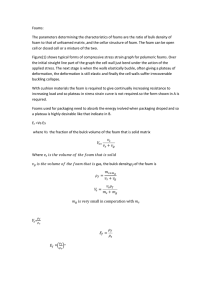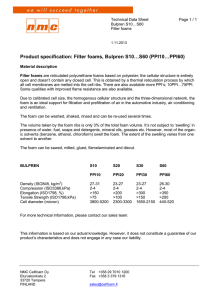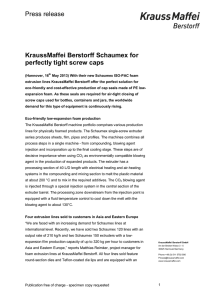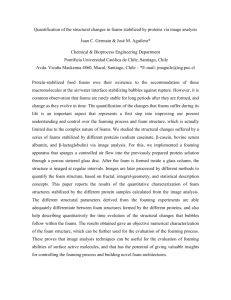malik engineers
advertisement
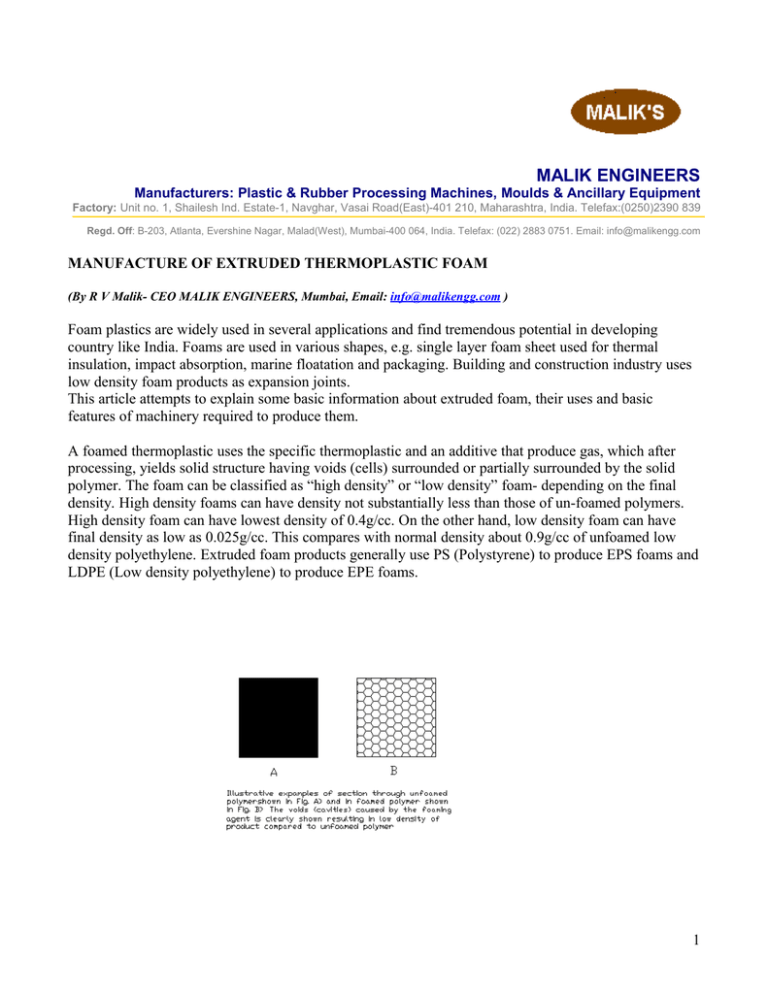
MALIK ENGINEERS Manufacturers: Plastic & Rubber Processing Machines, Moulds & Ancillary Equipment Factory: Unit no. 1, Shailesh Ind. Estate-1, Navghar, Vasai Road(East)-401 210, Maharashtra, India. Telefax:(0250)2390 839 Regd. Off: B-203, Atlanta, Evershine Nagar, Malad(West), Mumbai-400 064, India. Telefax: (022) 2883 0751. Email: info@malikengg.com MANUFACTURE OF EXTRUDED THERMOPLASTIC FOAM (By R V Malik- CEO MALIK ENGINEERS, Mumbai, Email: info@malikengg.com ) Foam plastics are widely used in several applications and find tremendous potential in developing country like India. Foams are used in various shapes, e.g. single layer foam sheet used for thermal insulation, impact absorption, marine floatation and packaging. Building and construction industry uses low density foam products as expansion joints. This article attempts to explain some basic information about extruded foam, their uses and basic features of machinery required to produce them. A foamed thermoplastic uses the specific thermoplastic and an additive that produce gas, which after processing, yields solid structure having voids (cells) surrounded or partially surrounded by the solid polymer. The foam can be classified as “high density” or “low density” foam- depending on the final density. High density foams can have density not substantially less than those of un-foamed polymers. High density foam can have lowest density of 0.4g/cc. On the other hand, low density foam can have final density as low as 0.025g/cc. This compares with normal density about 0.9g/cc of unfoamed low density polyethylene. Extruded foam products generally use PS (Polystyrene) to produce EPS foams and LDPE (Low density polyethylene) to produce EPE foams. 1 The above diagrams clearly show the cells formed in the foamed product making it light weight compared to un-foamed polymer. The control f cell size in processing is very important and it determines the final property of the foam and also whether it is of high density or low density category. High density foams are primararily used as permanent structures being sought for rigidity with weight reduction- e.g. replacement for wood in doors, windows and mirror frames and furniture components. In automotive, it is used in paneling, glove box door, instrument panels, vehicle crash barriers, etc. Typical markets for High density thermoplastic foams: Market Application Furniture Panels, frames, tables, seating, bed structures, drawers, And drawer fronts. TF, stereo component cabinets, equipment housings. Pallets, milk & soda cases, containers. Battery cases, underground conduits, handholds, Transformer housings, trash containers, equipment Covers and doors. Recreational, musical toys, coolers, totes, mirror and Picture frames, calendar and business card sheets, miscellaneous. Shutters, shingles, windows, doors. Washer tops and doors, dishwasher tops, tubs and bases, Air conditioner housing and bases. Decorative paneling, glove box door, instrument panels, Seat frames, fan shrouds, fender liners, vehicle crash Barriers. Fascia, seating, fish boxes, cabin structure. Cabinetry Material Handling Industrial Consumer Construction Appliances Automotive Marine Low density foam: Most low density foams have densities down to 3% than those of un-foamed polymer. Generally, low density foam is defined as foam product having density of 10% to 20% of unfoamed product. They can further be classified as rigid or flexible foam. Rigid foam is formed when base polymer is rigid (e.g polystyrene) while flexible foam is formed when the base polymer is flexible, e.g LDPE (polyethylene). This section mainly refers to production technology for LDPE low density or EPE Extruded foams. Extruded low density foam competes with traditional insulation products such as fiberglass and mineral wool as well as thermoset rigid polyurethane. It also competes with traditional shock mitigating products as foam rubber and straw as well as thermoset flexible polyurethane. Extruded low density plank is used to protect large and heavy shipments. Typical markets for low density foams: Comfort cushioning Flotation Shock mitigation Automotive, transportation, furniture seating, Mattresses, bedding and carpet underlay. Marine pier buffers, in-place flotation for Small vessels, marine life vests, pool Accessories, child toys. Package protection for light bulbs, eggs, fruit, Electronics, furniture, and machinery, surface 2 Thermal barrier Miscellaneous Protection for furniture and movers as overwrap, Crash barriers, etc. transportation of glasswares, Protection of mirrors, paintings, etc. Sidewall and roofing insulation, industrial Insulation for coolers, tanks, and reservoirs, Appliance and hot water insulation, insulative Packing containers for beer, carry outs. Disposable dishes & plates, egg trays, etc. Extrusion belongs to that class of Primary processing technique for polymers in which single or twin screws rotate inside a stationery barrel heated electrically. The principle of conventional single screw extrusion can be understood with reference to the following diagram: The screw rotates inside a stationery barrel. The mechanical energy for rotation is supplied by heavy duty gear box and electric motor. The barrel has a vertical feed opening through which the raw-materials are picked by the rotating screw(s), melted and conveyed forward in the barrel. The heat required for melting the polymer is supplied by electric heaters wrapped round the barrel plus friction heat generated due to mechanical energy being supplied by the rotating screw. The melted polymer is mixed homogenously and pumped past suitably shaped orifice fitted to the discharge end of the Extruder. This process produces continuous, long lengths which are cut in-line or wound on rolls. As is clearly shown in the schematic diagram. the extruder screw is divided into 3 zones, viz. feed, transition or compression and meter or pump zone. The functions of the various zones are clear from their respective names. The feed zone which has greatest depth serves to convey the pellets forward for other zones, the transition zone has tapered core which allows for gradual compression of the pellets to help in compaction and melting of the raw-materials, while the pump zone has shallow depth constantly over its length and serves to maintain the pressure required for pumping the melt through the die opening. The ratio of flighted length of screw to its diameter is referred to as ‘Length-to-Diameter Ratio” of the Extruder and is generally in region of 24:1 to 30:1 for conventional extruders- the pitch of screw flight being equal to diameter of the screw. The shaped product as it emerges from the extruder mostly needs additional handling(cooling/sizing) by other equipment (post extrusion equipment) placed in-line to give the required dimensions on the final product and also collect it suitably. 3 All foams begin with microscopic voids that grow on nucleating sites in the polymer melt (see figure below). All micro bubbles initially grow as isolated cells in a infinite medium of gas-laden polymer. The final product density depends on the blowing gas concentration, the rate at which the gas diffuses out from the matrix, the polymer melt temperature and external constraints on the foam as it expands, as well as upon the external calibrators used after extrusion. In high density foams, bubble shape is typically spherical to ovoid and bubble growth is restricted by cold metal constraints, blowing agent concentration and rapidly decreasing melt tempt. In low density foams, the growing cells thin the polymer into membranes. In the free-foaming process, the foam is allowed to expand freely in atmosphere as it comes out of the die- thus it has limitations on dimension control of the foam, whereas in the calibration process, there are calibrators placed after the extruder which constrain the foam and fix its dimensions. In general, all foams have primary characteristics of the respective unfoamed polymers. The final thermal and mechanical properties of the foam are determined primarily by the foam density. Chemically expanded foams: Chemically expanded foams are produced on conventional extrusion equipment by mixing the polymer with ingredients like nucleating agent, filler and certain exothermic chemicals e.g Azodicarbonamide (AZ) which decomposes by the heat inside the extruder, at approx. 200 deg. C, and produce gases which serve to expand the product as it emerges from the die. However, this process can be used only for producing high density product. Foam density can be 40-50% of the base polymer density. Low Density process: This process is used to produce very low density foam in form of sheet less than 12mm in thickness, profile, rod, pipe or foam netting. There are three methods of producing low density foams a) Long barrel single screw extrusion b) Tandem extrusion and c) Twin screw extrusion. Long Barrel Extrusion: 4 Low density foams need modified extrusion equipment for successful production. It is because instead of chemical foaming agents being premixed with the raw-materials, Physical blowing agent (PBA) are injected at high pressures inside the extruder barrel which mixes with the melt and lowers down the viscosity of compound to such an extent that proper foams cannot be formed. To overcome this, the screw has an additional function of cooling down the low viscosity melt to raise the viscosity required for successful foam production. It calls for low shear screw design in the cooling zone and additional cooling by water circulation to remove the excess heat from the compound. The final section consists of a specially profiled discharge screw to provide high pressure for pumping through the die and prevent premature foaming inside the processing equipment. It is very essential to maintain the compound inside the extruder and die at a pressure well above above the partial pressure of the PBA to prevent premature foaming. The single screw extrusion equipment is 45 to 50 Diameteres long for low density foam production. The PBA, un-like the chemical foaming agents, do not react chemically to release gases, since it is direct gas injected into the extruder. For efficient pumping, however, all PBAs are injected through metering pumps as liquids. Most common PBAs are Butane, liquid CO2, Isopentane, Dichlorodiflouromethane (R12) etc. However, R12 is now banned by most countries due to depletion of the protective ozone layer of atmosphere. Most common gases used for low density foam production is Butane. Since this gas is highly inflammable, proper safety measures should be followed inside the plant to avert accidents. The drawback of the above extruder is that good cooling calls for low screw speeds (to minimize frictional heat) while plasticizing calls for medium screw speeds. This results in compromise with consequent reduction in output because of low screw speeds. The advantage is low initial capital cost because one single extruder is used for plasticizing and cooling. To eliminate this drawback, the tandem extrusion technique is used: Tandem Extrusion: This uses two separate extruders- The primary extruder is used for plasticizing while the secondary is used for cooling. The two extruders are connected by a suitable pipe. The output of the primary forms the input to the secondary extruder. 5 In this case, the primary extruder is a separate unit with its own drive unit and can run at higher speeds to supply more production. Typical speeds are 75-100 RPM. The screw design includes the conventional feed, compression and meter zones in this section. There is an additional mixing zone to mix the blowing agent with the polymer homogenously. The secondary extruder- which is called as cooling extruder is of higher size (dia.) and runs at low rpm to supply more output and less shear energy for efficient cooling of the melt and PBA mix. Typical speeds range between 20-40 RPM. They have deep cut flights and large diameter to provide large heat dissipation area for cooling the melt. The screw channel depth is constant to provide minimum shear to the melt. The cooled mass is discharged through the die unit and the foam is formed immediately as it exits the die. Twin screw Extrusion: The twin screw extruders consists of twin screws inside a stationary single barrel. The screws fully intermesh to provide self-cleaning while running and minimum material hold-up. The two screws are either co-rotating (rotating in same direction) or counter-rotating (rotation in opposite sense). Twin screw machines provide good mixing and high output compared to single screw machines. Twin screw extruders for foam production are generally 25-30 diameters long. Counter rotating twin screw machines run at slower speeds and provide low shear mixing and cooling required for good foam production at high output. Some twin screw extruders have a specially designed heat exchanger (static mixer) between the extruder and die to remove additional heat from the gas-laden mass before extruding out through the die. This produces better quality and low density. Post Extrusion equipment: The extrudate as it emerges from the die expands in all directions due to the rapid escape of gases coming out of the solution. The product is either allowed to expand freely as it emerges out of the die, or as is usual, sized against the calibrator or mandrel to get the proper size of product. For producing single layer sheet upto 12mm thick, annular dies are used with due allowance for the blow-up or expansion 6 ratio and the product is drawn over a mandrel, which not only removes extra heat, but also sizes the product. The bubble is slit to get a single layer sheet which is passed over several idlers and finally wound in rolls. For producing foam pipe, simple circular die with a central core or pin is used, for rod a plain circular hole is used as die. For producing foam netting, specially designed dies with mechanical drives are used to make the open work structure of netting foam. Their design is held proprietary by manufacturers. In all these dies, the die orifice size is generally much smaller to account for expansion while the product emerges from the die. It should be noted, that, if foam products need additional processing, e.g coating with a thin layer of high density polymer, then sufficient time period should be allowed for the PBA to diffuse out completely, since after coming out of the die, the PBA continuously diffusing, and air diffuses in, long after the foam has been formed. There should be sufficient long-term warehousing period before surface finishing or coating is applied, so that re-heating in subsequent processes will not allow gases trapped inside to escape due to the coating layer. The result may be excessive surface porosity and blistering. Basic operations required for producing foam product: 1) Polymer system feeding- premix or multiple streams. It involves feeding the base polymer material in pellet form alongwith additives such as nucleating agents, cell stabilizers, lubricants, etc. either premixed together or metered in accurate amounts via. Separate feeders. 2) Melting/compounding- blend the base polymer, disperse nucleating agents, colorant, stabilizers, etc. in the plasticizing zone of extruder. 3) Dynamic sealing- is special zone designed on the extruder screw to prevent back flow of blowing agent towards the material hopper. 4) Gas injection- It is done with aid of High pressure (3000-5000 psig) multi-stage plunger metering pumps over the specially designed mixing zone on the extruder screw. 5) Cooling- injection of PBA reduces the melt viscosity. This zone of Extruder cools down the compound to temperatures between 80-100 deg. C. 6) Pumping- Pumping power for final die flow and maintain the melt at pressures well above the partial pressure of the blowing agent to prevent premature foaming in the equipment. 7) Die forming- To shape the product and allow right bubble growth. PRIMARY RAW MATERIALS NEEDED IN FOAM PRODUCTION: Foam recipe has two major components: 1) polymer(resin) and 2) foaming agent and minor components called as additives. Most common foaming polymers for Thermoplastics Extrusion are Polystyrene and LDPE (Polyethylene). Nucleants: Nearly all foams employ employ nucleating agents in concentration of 1-1.5% by weight. The primary role for a nucleant is to provide surfaces on which bubbles can organize and grow. They provides as sites for bubble growth. Microfine grades provide fine cell structures. Talc is most common passive nucleant used in foam production. There are also active nucleants which, in addition to providing sites for bubble growth, also provides additional gas required for expansion, e.g certain chemical foaming agent alongwith PBA not only serve as nucleant, but will help in attaining low density because gases are evolved out when they are heated inside the equipment. Cell stabilizers: These are used to produce stable foams. As cells are growing, the diffusion rates of certain blowing gases are so high that the gas is lost very quickly from the foam. The result is cell collapse and excessive shrinkage. Small amounts if cell stabilizers, typified by GMS (Glycerine monosteareate) are soluble in polymer at melt tempt. but phase separate as the polymer cools and cells 7 form, providing monolayer coatings on the membranes. This inhibits the diffusion rate through the membrane. Concentration is usually less than 1% by weight. In addition to the above primary ingredients, the compound may include fillers and re-inforcing agents, antioxidants, antistatic agents, colorants, fire retardants, external or internal lubricants, etc. but some may interfere with nucleation or cell stabilization and their properties and effects should be carefully studied before using the same. Processing: For producing Chemically expanded foams, all ingredients alongwith the pellets are pre-mixed and loaded in the hopper of the conventional extruder and the material is heated above the melting tempt. of resin. The chemical foaming agent decomposes inside the extruder due to the applied heat and evolves blowing gases required for expansion, as the product emerges out of the die. Inside the extruder, the temperature is maintained from 80 to 250 deg. C rising towards the exit end. Screw rpm is adjusted as per requirement. Satisfactory high density foams about 40-50% density than that of unfoamed polymer are produced. High density flexible wad sheet is also produced by the above process using “T” die and conventional sheet take-off equipment. Of late, such sheet is also produced by blowing gas injection process, wherein liquid CO2 gas is pumped into the melted resin to attain lower densities. Density of around 0.2g/cc has been attained by this process. For low density foam production, it is should be noted, that, the blowing gas is externally injected at very high pressures (3000-5000 psig are common) through plunger type multiplex metering pumps and it should be ensured, that, the material is fully molten at the time of injection or gas blow-back may occur preventing formation of cells in the foam. High injection pressures are required to ensure maximum solubility and homogenous mixing with the melted resin to achieve lower densities. Low density process requires more careful setting of the process parameters and in the cooling zone, the temperature is held not more than 80-100 deg.C for PE or PS foams to attain proper melt conditions. Though all the ingredients can be pre weighed and premixed in a tumbler mixer and loaded in the hopper, it is desirable to load the components separately by respective screw feeders or gravimetric hoppers for best results. The gas injection should be through non-return or check-valve to prevent any back flow of melt in the injection nozzle and clog the gas lines in event of loss of blowing gas pressure. The expanded product from the die is constrained by calibrators which also serve to cool down the foam. The rigid foam is cut in desired lengths for storage and flexible foam is wound in large diameter rolls or spools. Process wastage generated in the process is usually stored in clean area and reground for reuse with the virgin resin. Gas lines should be insulated to minimize temperature rise of the blowing agents, since they have very low boiling points and it is necessary to pump the gases as liquids through the pumps. Blowing agents can be used singly or in combination (e.g pentane and carbon dioxide combination) with individual control of dosages in the multistage metering pump. Volatile blowing agents are dangerous (butane, propane, pentane, etc.) and require careful handling in the plant to save accidents. Certain CFC gases like R11, R12 were used with polyethylene, but have now been banned for depleting the ozone layer of atmosphere. (The Author is CEO of Malik Engineers, Mumbai which manufactures wide range of Thermoplastic Extruders. He can be reached on info@malikengg.com , Mob: 09821676012) (This is the end of article) 8
